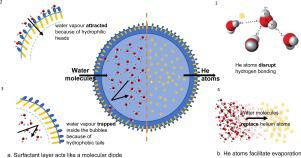Journal of Environmental Chemical Engineering ( IF 7.7 ) Pub Date : 2020-07-26 , DOI: 10.1016/j.jece.2020.104303 Rui Wei , Richard M. Pashley

|
The bubble column evaporator (BCE) can be used as an improved thermal desalination technology simply based on pumping a heated gas, such as helium, through a porous sinter to produce hot gas bubbles to transfer heat and mass across the water-gas interface. In this paper, a “molecule diode” effect caused by surfactant monolayers has been proposed, because adding surfactants into the column solution produced an improved evaporation efficiency. The mechanism involved appears to be based on enhancing water molecule transport across the bubble surfaces from the column solution via the hydrophilic headgroups, whilst restricting water vapour molecules returning to the solution because of the layer of hydrophobic tails coating the inside bubble surface. In this paper, the enthalpy of vaporization (△Hv ) was estimated, and the bubble saturation period and the bubbling and foaming behaviour was observed, to study the performance of surfactants on improving the evaporation efficiency achieved by the BCE process. Myristyltrimethylammonium bromide (MAB), a typical cationic surfactant, combined with the moderately heated helium bubbles generated in the BCE column, performed best by reducing the apparent △Hv value for water by 15 % and increasing the evaporation efficiency by 2.3 times, compared with the value for non-surfactant column solutions pumped with air, which demonstrates the potential for a low cost thermal desalination technology based on this sub-boiling process.
中文翻译:

吸附的表面活性剂层引起的“分子二极管”效应提高了用于海水淡化的鼓泡塔蒸发器(BCE)的蒸发效率
气泡塔蒸发器(BCE)可以用作改进的热脱盐技术,仅基于将诸如氦气之类的加热气体通过多孔烧结体泵入即可产生热气泡,从而在水-气界面上传递热量和质量。在本文中,已经提出了由表面活性剂单层引起的“分子二极管”效应,因为在柱溶液中添加表面活性剂可提高蒸发效率。所涉及的机理似乎是基于增强水分子通过亲水头基团从柱溶液跨过气泡表面的传输,同时由于覆盖气泡内部表面的疏水尾部层限制了水蒸气分子返回到溶液中。本文中的蒸发焓(△H v估计),并观察气泡饱和期以及起泡和起泡行为,以研究表面活性剂对提高BCE工艺获得的蒸发效率的性能。典型的阳离子表面活性剂肉豆蔻基三甲基溴化铵(MAB)与BCE色谱柱中产生的中度加热的氦气气泡相结合,通过将水的表观△H v值降低15%并将蒸发效率提高2.3倍而表现最佳空气泵送的非表面活性剂色谱柱溶液的价值,这证明了基于该次沸腾工艺的低成本热脱盐技术的潜力。


























 京公网安备 11010802027423号
京公网安备 11010802027423号